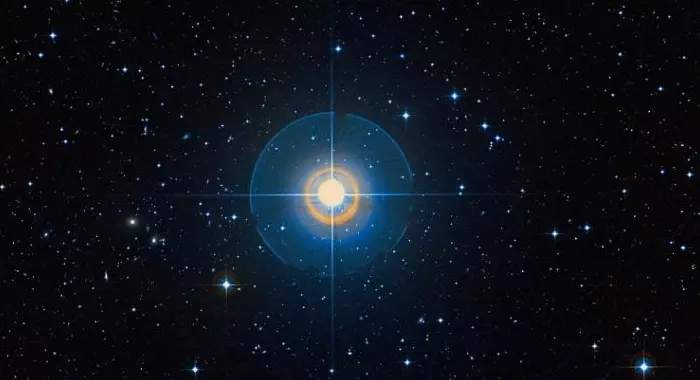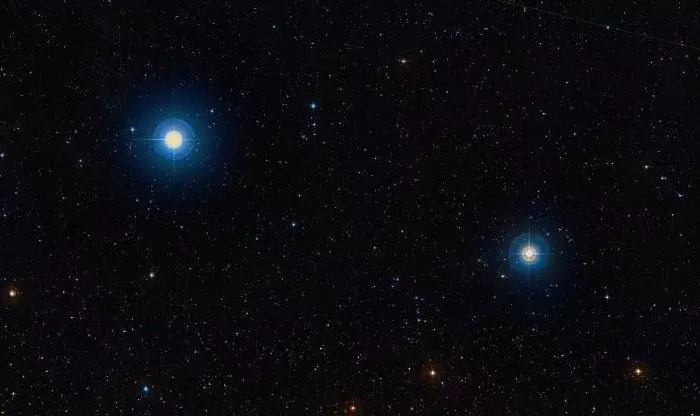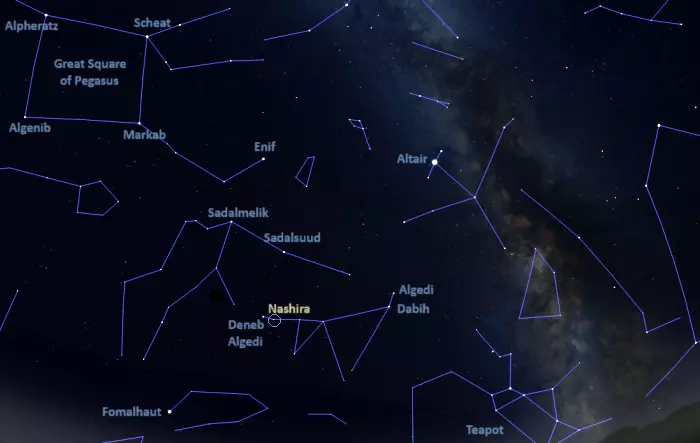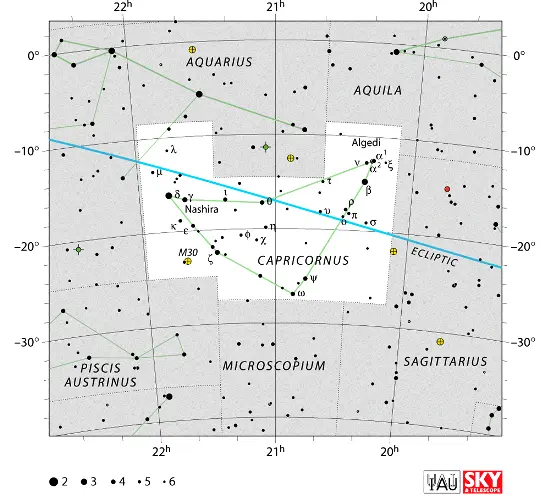Nashira, Gamma Capricorni (γ Cap), is a variable star located approximately 157 light-years away in the constellation Capricornus. With an apparent magnitude of 3.67, it is the fourth brightest star in the constellation, after Deneb Algedi, Dabih, and Algedi. It appears in the tail of the Sea Goat, near Deneb Algedi.
Star type
Nashira is a giant star with a mass 2.44 times that of the Sun and a radius 2.35 times the Sun’s. It has an effective temperature of 7,520 K and spins at 40 km/s.
Nashira is a chemically peculiar star whose evolutionary status is somewhat uncertain. It has been classified as a main sequence star of the spectral type kF0hF1VmF2 and as a white A-type star (A7). The surface temperature of 7,520 K indicates spectral class A.
Nashira has been identified as an Am star, a metallic-line A-type star with strong absorption lines of metals such as strontium, zinc, barium and zirconium, and deficiencies of elements such as calcium and scandium. The star’s spectrum shows abundance anomalies of strontium, chromium, and europium.

Nashira (Gamma Capricorni), image: Wikisky
Nashira shows large variations in radial velocity, which may be an effect of star spots coupled with rotation. The variations may also be explained if the star were in fact a double-lined spectroscopic binary system seen almost pole-on.
The brightness of Nashira has been observed to vary by 0.03 magnitudes. The star is classified as an Alpha2 Canum Venaticorum variable, a chemically peculiar main sequence star with strong lines of silicon, strontium or chromium and strong magnetic fields.
Brightness variations in Alpha2 Canum Venaticorum variables are believed to be caused by an uneven distribution of metals in the stars’ atmospheres, which causes the brightness of the stellar surface to vary from point to point. Other stars in this class include the class prototype Cor Caroli in the constellation Canes Venatici, Alioth in Ursa Major, Alrescha in Pisces, Mesarthim in Aries, and Mahasim in Auriga.
Facts
Nashira lies only 2.56 south of the ecliptic and can be occulted by the Moon and planets. Planetary occultations are much rarer.
Nashira was classified as an Am star by Japanese astronomer Kiyoteru Osawa in 1965. In 1974, C. Bertaud and M. Floquet identified it as an Ap star, a chemically peculiar star with an overabundance of metals such as strontium, europium, and chromium and a stronger magnetic field than a typical A-type star. The classification as an Ap star was confirmed by F. A. Catalano and associates, who found a slight variation in the infrared J band with a 2.78-day period in 1998. However, a magnetic field has not been detected, which indicates an Am star.
Name
The name Nashira (pronunciation: /ˈnæʃɪrə/) comes from the Arabic sa’d nashirah, meaning “the lucky one” or “the bearer of good news.”
The name was approved by the International Astronomical Union’s (IAU) Working Group on Star Names (WGSN) on August 21, 2016.
In Chinese astronomy, Nashira was known as 壘壁陣三 (Lěi Bì Zhèn sān), the Third Star of Line of Ramparts. It formed the Line of Ramparts asterism with Kappa Capricorni, Epsilon Capricorni, Deneb Algedi (Delta Capricorni), Iota Aquarii, Ancha (Theta Aquarii), Lambda Aquarii, Phi Aquarii, 27 Piscium, 29 Piscium, 33 Piscium, and 30 Piscium. The asterism was part of the Encampment mansion, one of the northern mansions of the Black Tortoise. It represented fortifications around the barracks.

Deneb Algedi and Nashira, image: Wikisky
Location
Nashira is easy to find in good conditions because it lies near a relatively bright asterism, the Lightning Bolt. The star appears next to Deneb Algedi, which forms the Lightning Bolt with Sadalsuud and Sadalmelik in the constellation Aquarius and Enif in Pegasus. Deneb Algedi and Nashira appear about two fifths of the way from Fomalhaut in Piscis Austrinus to Altair in Aquila. Both stars are part of the faint V-shaped constellation figure of the Sea Goat.

The location of Nashira (Gamma Capricorni), image: Stellarium
Constellation
Nashira is located in the constellation Capricornus, the Sea Goat. Capricornus is one of the 48 ancient constellations listed by the Greco-Roman astronomer Ptolemy in his Almagest in the 2nd century CE. Like all zodiac constellations, it lies on the ecliptic, the Sun’s apparent path across the sky. In Greek mythology, Capricornus is associated with the forest god Pan and the goat Amalthea, who nursed Zeus when he was an infant.
The constellation occupies 414 square degrees of the sky south of the celestial equator. It is the 40th constellation in size. It contains only one star brighter than magnitude 3.0 – the white giant Deneb Algedi (Delta Capricorni Aa) – and is not particularly conspicuous in the sky.

Capricornus constellation map by IAU and Sky&Telescope magazine
Deneb Algedi, the brightest star in Capricornus, shines at magnitude 2.81 from a distance of 38.70 light-years. It is part of an Algol-type eclipsing binary system.
Other notable stars in the constellation include the multiple star systems Alpha2 Capricorni (Algedi) and Beta Capricorni (Dabih), the yellow supergiants Alpha1 Capricorni and Zeta Capricorni, the star system Pi Capricorni, the yellow giant Iota Capricorni, and the orange giant Omega Capricorni.
Notable deep sky objects in Capricornus include the bright globular cluster Messier 30, the globular cluster Palomar 12, the interacting pair of galaxies NGC 7035 and NGC 7035A, and the spiral galaxies NGC 6907 and IC 1337.
The best time of the year to see the stars and deep sky objects in Capricornus is during the month of September, when the constellation rises higher in the sky in the evening. The entire constellation is visible from locations south of the latitude 60° N.
The 10 brightest stars in Capricornus are Deneb Algedi (Delta Cap, mag. 2.81), Dabih (Beta Cap, mag. 3.05), Algedi (Alpha2 Cap, mag. 3.57), Nashira (Gamma Cap, mag. 3.67), Zeta Capricorni (mag. 3.77), Theta Capricorni (mag. 4.07), Omega Capricorni (mag. 4.11), Psi Capricorni (mag. 4.13), Iota Capricorni (mag. 4.296), and Alpha1 Capricorni (mag. 4.27).
Nashira – Gamma Capricorni
| Spectral class | kF0hF1VmF2 or A7 |
| Variable type | Alpha2 Canum Venaticorum |
| U-B colour index | +0.22 |
| B-V colour index | +0.32 |
| Apparent magnitude | 3.67 |
| Absolute magnitude | +2.60 |
| Distance | 157 ± 5 light-years (48 ± 2 parsecs) |
| Parallax | 19.1037 ± 0.6765 mas |
| Radial velocity | −31.2 ± 0.5 km/s |
| Proper motion | RA: +200.193 ± 1.071 mas/yr |
| Dec.: −9.578 ± 0.605 mas/yr | |
| Mass | 2.44 M☉ |
| Radius | 2.35 R☉ |
| Temperature | 7,520 K |
| Metallicity | 0.5 dex |
| Rotational velocity | 40 km/s |
| Surface gravity | 3.69 cgs |
| Constellation | Capricornus |
| Right ascension | 21h 40m 05.4454210419s |
| Declination | −16° 39′ 44.536313677″ |
| Names and designations | Nashira, Gamma Capricorni, γ Cap, 40 Capricorni, HD 206088, HR 8278, HIP 106985, SAO 164560, FK5 812, BD−17°6340, GJ 4209, GC 30320, GCRV 13603, GSC 06362-01078, JP11 3373, UBV 18602, IRAS 21373-1653, 2MASS J21400544-1639443, PPM 239166, PLX 5222.00, TYC 6362-1078-1, Gaia DR2 6838023243053277312, Gaia DR3 6838023243053666688 |